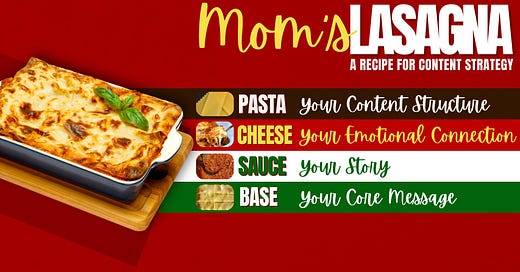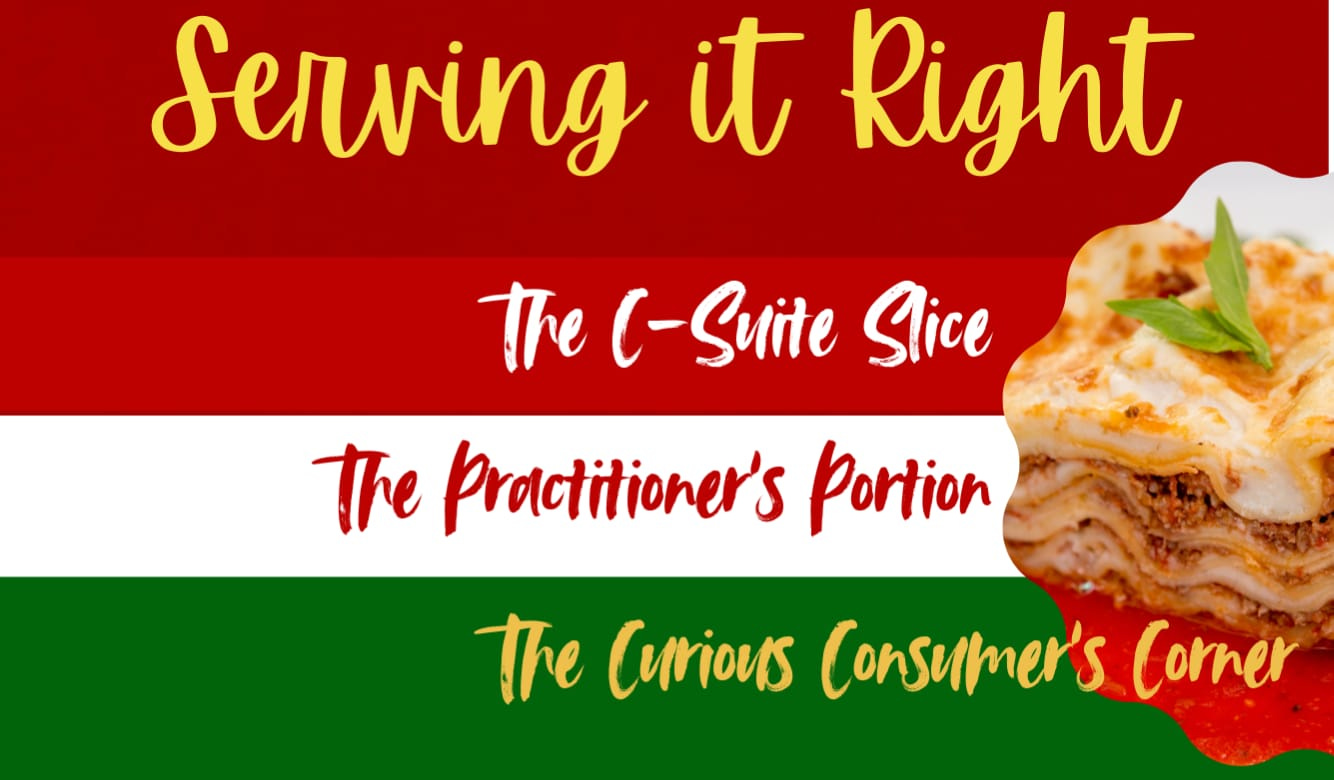What Mom’s Lasagna Can Teach You About Content Strategy
How to layer your content like a classic lasagna—and slice it differently for your audience
There's something sacred about a mom's lasagna.
There's something strategic about a great lasagna.
The prep takes time. The layering is deliberate. And somehow it satisfies everyone at the table differently.
If you're struggling with content creation that feels scattered and exhausting, maybe you're overthinking it. You don't need a hundred different ideas. You need one great idea—layered thoughtfully and served differently based on who's consuming it.
Let's break it down.
🧱 Base: Your Core Message
Every lasagna needs a solid foundation. In your content strategy, this is your core message.
Ask yourself: What's the ONE thing I want to be known for? What belief or perspective runs through everything I publish?
Example: If you're a tech founder obsessed with ethical AI, your core message might be: "AI must serve humans—not replace them."
That's your base layer. Everything else builds on this.
Pro tip: You don't need multiple positioning statements. You need one strong one—repeated over and over until it sticks. (I wrote about creating your perfect tagline here.)
"The essence of strategy is choosing what not to do."
— Michael Porter
The real power of a strong positioning comes not just from what you say but what you deliberately choose not to say. Strategic content means:
NOT trying to appeal to everyone
NOT diluting your message with too many topics
NOT jumping on every trending conversation
📬 Like what you're reading?
This kind of insight-led breakdown is what Luminary is all about.
Subscribe to get future issues—layered with clarity, not clutter.
🍅 Sauce: Your Story
Your sauce is where the flavor lives. It's rich, simmered, and full of depth. Your sauce is made of stories, examples, and metaphors—the elements that bring your positioning to life.
Example: That same tech founder could tell a story about a time an algorithm made a biased hiring decision—then reflect on how they fixed it.
Or compare AI models to toddlers: fast learners, but in desperate need of supervision.
These narratives don't dilute your message. They enrich it.
🧀 Cheese: Your Emotional Connection
In lasagna, cheese is the binding agent. In content, it's emotion. Humor, vulnerability, or curiosity. Emotion is what makes people remember you.
Example: The founder might talk about the moment they realized their own team was unknowingly serving biased data to train the model. Maybe it was uncomfortable. That's the cheese—it makes the content personal, not generic.
🍝 Pasta: Your Content Structure
Just like lasagna needs layers of pasta between ingredients to hold shape, your content needs a structured plan to scale.
That means knowing:
Which ideas become blog posts
Which ones are distilled into short-form
What gets saved for keynote talks or newsletters
How to maintain a consistent tone and voice across formats
Don't just create content. Create a system for that content.
🍽 Serving It Right: Audience-Specific Slices
Here's where the metaphor gets practical: Mom knows exactly who needs which slice of the lasagna.
The same way, your content should be intentionally sliced for different audience segments—based on their role, knowledge level, and content consumption habits.
The C-Suite Slice
What they need: Condensed insights, business impact, ROI
How to serve it: Executive summaries, data visualizations, competitive insights
Example: “How ethical AI improved hiring diversity by 40% while cutting costs.”
The Practitioner's Portion
What they need: Implementation details, how-to guides, practical tools
How to serve it: Tutorials, checklists, templates, code examples
Example: “How to audit your AI for bias: a 5-step guide + free checklist to try it on your own system.”
The Curious Consumer's Corner
What they need: Relatable stories, clear explanations without jargon
How to serve it: Analogies, day-in-the-life scenarios, visual storytelling
Example: "What your Netflix recommendations teach you about AI bias"
🔄 Cross-Platform Plating
Just like mom might serve lasagna differently for a fancy dinner versus leftovers for lunch, your core content changes form based on the platform:
LinkedIn: Your in-depth case study becomes a data-rich carousel with 7-10 slides showcasing key insights.
Twitter: Convert your main point into a provocative question or counterintuitive insight: "Our AI flagged more white male candidates than any other group. Here's why that shocked us."
Instagram: Create a simple visual metaphor representing your concept, with a story that explains the behind-the-scenes thinking.
Newsletter: Share the personal journey—what you tried, what failed, what finally worked, and what you learned.
Blog: Dive deep with comprehensive analysis, supporting research, and implementation guides.
Remember: It's not about creating more. It's about strategically adapting what you've already created.
♻️ Leftovers Are a Feature, Not a Bug
Great lasagna tastes better the next day—because the flavors have time to settle.
In content, you don't need to create constantly. You need to create smartly. Reuse your best thinking. Reheat your greatest hits. Build depth, not just volume.
That viral tweet? Turn it into a newsletter deep-dive.
Last month's case study? Extract the framework and turn it into a template.
Most creators abandon great content too soon. But if you go back to it—add a new story, reframe it for a different audience segment, update the take—it can be even stronger.
👩🍳 Final Thought: Your Strategy is Homemade
The most memorable lasagna is always home-made. It's personal. It's layered with care.
Your content strategy should feel the same way. It doesn't need to be complicated. It needs to be layered.
Here’s the recipe recap:
Start with a clear core message
Add flavor through relevant stories and real-world examples
Bind it with emotion
Structure it systematically
Slice it for different audiences with care
Repurpose and give your best ideas a second life
Just like mom’s lasagna, it works because it's both structured and adaptable—reliable but never boring.
And if you're doing it right—your audience will keep coming back for second servings.
This Week's Action Step
1. Identify your base layer — What ONE message do you want to be known for?
2. Map your slices — Who are the 3-4 distinct groups you're serving?
3. Pick a leftover — What’s one piece of content you’ve already created that you can repurpose this week in a different format?





